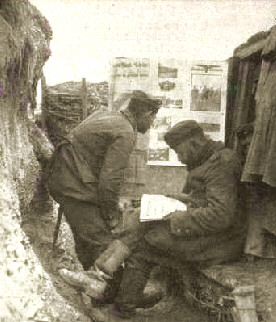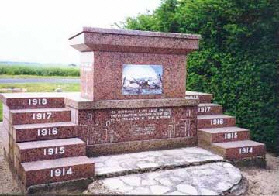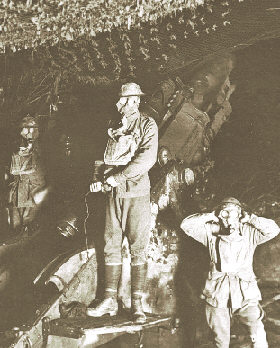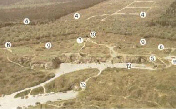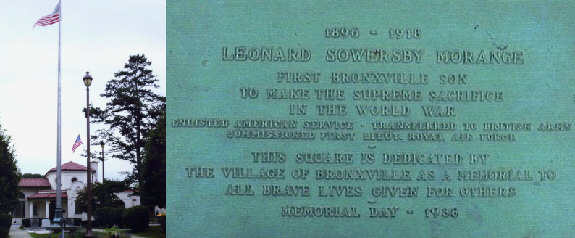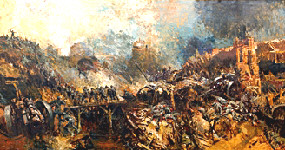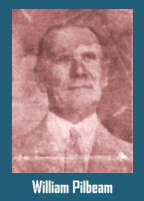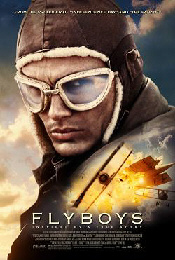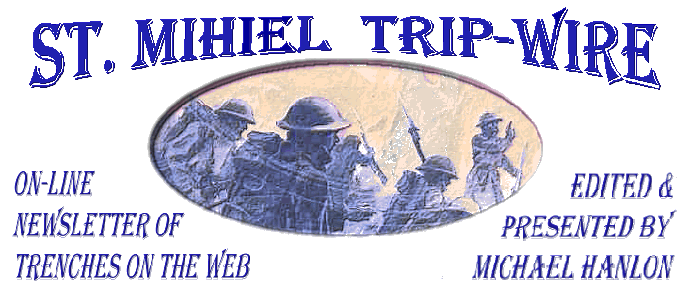
October 2006 |
Access Archives |
|
TRENCH REPORT: Readers sometimes send inquiries about possible parallels between the Great War and the present War on Terror. I haven't found an explicit treatment of that subject, but there are a number of cutting edge articles attempting to place Terrorism in a historical framework being published by the Hoover Institution. Go to this page and scan the articles -- all accessible on-line (link). . .Trip-Wire Contributor, Ambassador Len Shurtleff, sent some interesting follow-up on last month's article covering the WWI activities of Allen Dulles. In addition to being a grandson, nephew and brother of three Secretaries of State, Dulles is also credited with drafting the "War Guilt" clause of the Treaty of Versailles while a member of the US delegation at the Paris Peace Conference. . .Next month - Our Fourth Anniversary Issue!
MH Q-Ships
|
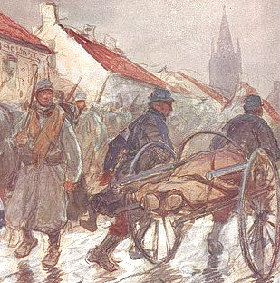
Detail from 1915 Illustration |
|||||||||||||||||
GREAT WAR 2006 EVENT CALENDAR | |
|
90th Commemorative Events Comprehensive Double Calendar Scheduled Throughout 2006 (link) | |
|
Cleveland Gray's Armory October 21st (link) | |
|
UCLA, October 12-14, 2006 Los Angeles, CA (email for details) | |
|
Baltimore War Memorial November 4th (Program) | |
|
Hartford, Connecticut November 11th (Program) | |
|
Great War Poster Artists and Luncheons With our Friends Jean- Pierre & Cecile Mouraux Sonoma, California, November 11th (details) | |
|
Email Response |
|
|
Harry Potter himself, Daniel Radcliffe, has signed on for an upcoming British TV movie. Radcliffe will play Jack Kipling in My Boy Jack, which will air next fall on British channel ITV. Joseph Fiennes, formerly the title character in Shakespeare in Love, is playing Canadian Capt. Roy Brown in the German financed Red Baron, now filming.
The Simon Wiesenthal Library in Los Angeles recently exhibited a water color by Adolf Hitler. It is displayed with a number of WWI photos at this site. (link)
Call for Papers: FOURTH CONFERENCE OF THE INTERNATIONAL SOCIETY FOR FIRST WORLD WAR STUDIES; October 18-20, 2007; Washington D.C. USA.
Topic: New Directions in First World War Studies
Applicants please send a two-page abstract of the proposed paper and a curriculum vita to Jennifer Keene at (email) or Mike Neiberg at (email) by February 1, 2007. Please also be prepared to submit a paper of a maximum of 8,000 words by June 1, 2007. (link)

Two from a Great War Casualty:
Homer is new and fresh this morning, and nothing, perhaps, is as old and tired as today's newspaper.
The world has changed less since Jesus Christ than it has in the last thirty years.
Charles Péguy,
KIA at the Marne,
4 Sep 1914

Click Here for News on Travel Opportunities |
We have received announcements of the passing of two World War I veterans:
- George Johnson, 112
- US Army, believed to be the oldest person and last surviving WWI veteran of California.
(link)
- Francois Jaffre, 105
- The youngest of the six known remaining French veterans died on 22 September at the age of 105;
he joined the French navy in October 1916 and later served on escorts for US troop convoys.
(link in French)
 |
An Englishman
At Verdun
By Christina Holstein
People often ask me if any Englishmen fought at Verdun. The only
'English' name I've ever come across is that of Arthur Exshaw, who
served as a Corporal in the French 49th Infantry and died at Verdun on
23 May 1916. I am indebted for the information which follows to the
descendants of Arthur's cousin, Ronald Exshaw, who served in the
Coldstream Guards as a private soldier.

Although born in France, Arthur Exshaw came from an English-speaking family. His ancestors were from Ireland but, following the end of hostilities between England and France in 1814, the family moved to Bordeaux and started producing red wine and cognac (brandy) for export to 'home' markets.
 La Caillette Alcove Douaumont Ossuary |
The Exshaw's kept up their Anglo-Irish connections and the children continued to be educated in England. Arthur's uncle, Albert Exshaw, had served in the Coldstream Guards and died following service in South Africa. Another uncle, William, was commissioned in the Bedfordshire Regt. and later won a Gold Medal in the 1904 Olympics. The town of Exshaw, Canada, is named after one of Arthur's aunts. The Exshaw family sold the cognac business in the 1970s.
Caillette Wood, where Arthur Exshaw died, was the scene of vicious fighting during the battle of Verdun, in particular during the first French attempt to retake Fort Douaumont which lasted from 22-24 May 1916. The 49th Infantry was based at Bayonne in south west France and saw prolonged service in Champagne and Verdun during WWI.

|
A WWI Yank in the RAF |
 |
Lt Leonard Sowersby Morange,
RFC/RAF
Bronxville, N.Y. U.S.A
In the village of Shotwick on the outskirts of Chester in the county of Cheshire and at Shawbury in the county of Shropshire U.K there are two churches that have an area for military causalities from WWI. Amongst these are causalities who served in the Royal Flying Corps/Royal Air Force, at Shotwick there are four Americans who lost their lives as a result of flying accidents in 1918, one was disinterred and repatriated in 1920. The other airman is interred at Shawbury, near Tern Hill where the Royal Air Force continues to teach pupils to fly helicopters. One of the American airmen whose is interred at Shotwick is Lt L.S.Morange whose family from Bronxville USA have supplied information for this article.
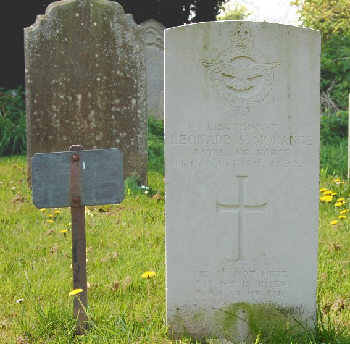
Lt. Morange's Grave at Shotwick
(Care of this grave has been undertaken by Mr. J.Pritchard and family who live in Chester, UK)
Leonard Sowerby Morange had been a pupil at Yale before leaving in May 1917, he was for a short time in The Reserve Officers Training Corps, he later entered the first officers Training camp at Madison Barracks N.Y. On completing his training he was anxious to get overseas in particular to apply to join the Royal Flying Corps in England. In July 1917 he gained his honourable discharge allowing him to take and pass the initial examination qualifying him become a member of the RFC.
Before he came to England his flying lessons were in Texas and Canada, being commissioned on November 27th with the rank of Second Lieutenant. On his arrival in England training continued at Market Drayton, possibly Tern Hill in the county of Shropshire and Lilbourn near Rugby. In February 1918 he was promoted to First Lieutenant and eager to advance his already flying abilities he entered the "Gosport Course" this taught advance techniques in map reading and aerobatics. This course of flying training was established by Major (later Lieutenant Colonel) Robert Raymond Smith-Barry at the School of Special Flying at Gosport. Hence the colloquial name the course acquired. This school at the time was seen as revolutionary and the pilots who were taught there to be flying instructors were seen as superior to those trained elsewhere. A key part of Major Smith-Barry's revolution was the production of the first ever manual on how to be a flying instructor. Lt Morange was amongst the few who passed and gained this much prized certificate, as a result, he was appointed to the staff of the 55th Training Squadron at Lilbourn, England as an instructor in advanced training and aerial acrobatics. In June 1918 the squadron was posted to Shotwick transferring to the 51st Training Depot Squadron. It was a result of midair collision during training that cost the lives of Lt Morange and his pupil.
At the base of the Flag Pole memorial is a list of all the names of the servicemen from the 1st WW, this includes the brother of Lt Morange, Irving, also an aviator who served as a pilot in the USAS in France during the 1st WW he was awarded the Croix-de-Guerre, possibly for continuing with the reconnaissance flight over enemy lines, which resulted in him being wounded in the thigh.
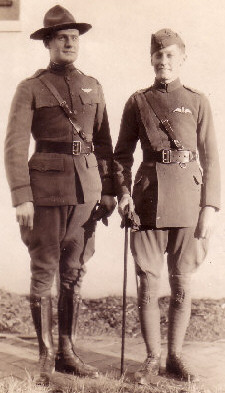 Irving and Leonard In their Uniforms of the Royal Air Force Great Britain, and the United States Air Service |
In the souvenir Catalogue for the 1919 Aeronautical Exposition held at Madison Square Garden and the 69th Regiment Armoury (March 1-15, 1919) in New York City, Edward Morange wrote the following in honour of his son Leonard.
To you, hovering twixt youth's and man's estate,
You clear-brained, gentle-eyed boy's
Who, like eaglets, with untrained pinions
Sprang from your sheltered nests
To stay the vulture's claws
To you, conquerors of the air,
With man-made wings,
Who paid the price,
That right should prevail
This homage is paid to the memory
Of one of Yale, 1918
And to all
Who won't come back?
E.A.M
Acknowledgements:
Mrs. Dale Walker, Bronxville USA, great, great niece of Lt Morange; Mr. J. Kennedy, Bronxville USA Mrs. Eloise Morgan, Bronxville Historian; USA Mr J. Pritchard, UK; Royal Air Force Museum UK; Commonwealth War Graves Commission UK; Mr L. Shurtleff WFA-USA; I am more than grateful to Mrs Dale Hanson Walker, great, great niece of Lt Leonard Morange, Bronxville NY, for the personal information and family photographs.
|
Verdun |
 |
The Somme | |
The time had come. Click Here to See a Large
|
The dust of the tortured destroyed soil turned to mud, the mud filled the tracks, the scratched out trenches and the joined up shell holes. The guns positions filled with mud and the gun and supply horses died from exposure by their hundreds.
Click Here to See a Large
|
|
|
|
|
in the 21st Century |

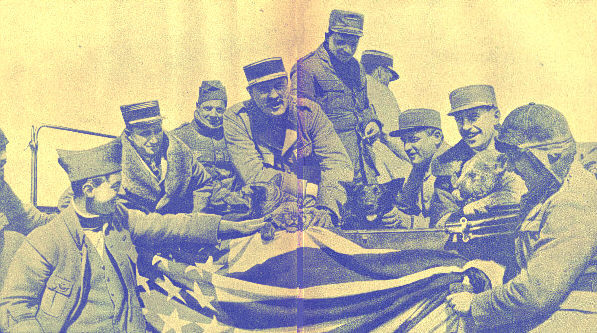
Members of the Lafayette Escadrille, 1916
Sgts. Willis, Dugan, Captain Thenault, Sgt. Hewitt, Lt. Thaw, Sous Lt. Lufbery, Lt. de Laage, Sgts Marr, Parson, Hinkle, Plus Two Dogs [Unidentified] and Two Lion Cubs, Whiskey and Soda
|
||||||
Ticehurst House Hospital was a sanatorium founded by Samuel Newington in 1792. At first described as a lunatic asylum, then gradually changed to the more salubrious 'sanatorium', the hospital at initially admitted poorer patients, but gradually became known as a place for wealthy private clients. The Hospital continues to accept private patients today. During the war it continued its role and housed both wealthy patients and soldiers. 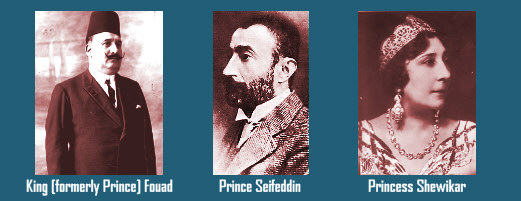 The Prince might possibly have been released sooner, had it not been for the outbreak of the war. The declaration of the British protectorate over Egypt meant the end of Turkish rule and more importantly, the deposition of Abbas II in 1914. He was replaced at first by Hussein Kamel in 1917, but then by his brother Fouad in 1917 after his death. The new king did not forget old wounds and a number of decrees meant that the Prince stayed firmly where he was within the walls of the old Kent hospital. The plot thickened and on 18 August 1925, the Prince's financial guardian was suddenly dismissed for fraud. On 4 September, the Prince was reported to have escaped from Ticehurst. Nobody was really who was involved in the plot. Whether governmental assistance was involved was unknown, and although it was strongly suspected that Seifedden's mother, the Princess Tougan must have provided funding, little else of the details are known. After escaping, some details on the Prince's escape were published in Al-Ahran Weekly. On 30 September, the Prince eluded his guards and sailed to France, rejoining his mother and her husband. The Prince shaved off his beard and kept a low profile 'until they were able to obtain passports, at which point they drove to Marseilles and sailed to Istanbul, travelling second class in order not to draw attention.'
Both of these men took part in a war that hardly ever occurs to us. The plotting on both sides meant that the Prince was left in Ticehurst during the war, and throughout Mr. Pilbeam was worked in the hospital. Both would have encountered those who fought on a daily basis. The interesting thing here is perhaps, who was fighting the greater battle? (link) Click on the icon below to visit her site. |

|
Forgotten Soldiers of the First World War
Editor of Len's Bookshelf |
Drawing heavily on unpublished letters and diaries, this book examines the fighting advance of the British Egyptian Expeditionary Force from the banks of the Suez Canal 500 miles across the Sinai Desert to Jerusalem and Damascus under two successive commanders: Sir Archibald Murray; and, Sir Edmund "Bull" Allenby. Murray is described as a distant and meticulous staff officer unwilling to delegate authority, while ultimately victorious Allenby is a much more intuitive and free-wheeling commander, a cavalryman who left detailed planning and execution to subordinates while developing a real bond with his troops.
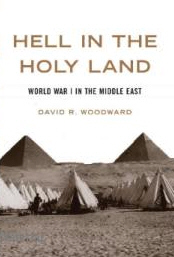 American Edition |
The British troops involved were also different from most of those deployed to the Western Front. These were territorial force infantry and yeomanry rather than the raw volunteers of the new Kitchener armies. As such, they had a considerable unit cohesion that came from common peacetime training and from long established civilian relationships.
Moreover, the campaigns in Egypt and Palestine (not to mention Mesopotamia) were not sideshows. The Suez Canal, the British lifeline to India, and other key British assets in Egypt were under threat. The Ottomans and Germans had designs on oil-rich Persia (from where the Royal Navy drew 25% of its fuel oil), and sought to foment rebellion against the Raj in volatile Afghanistan and India. The Ottoman Turks, ably supported by German officers, air power and specialist troops were a tenacious and formidable foe. If Lloyd George had prevailed and the Germans not attacked in the West in the spring of 1918, Britain would have mightily reinforced Allenby in an attempt to knock the Ottomans out of the war in early 1918. As it was, some 60 thousand of Allenby's best troops were redeployed to Flanders and replaced by British Indian Army infantry.
Finally, British troops, steeped in a Protestant Christian ethic, were mindful of advancing through the Holy Land where Jesus had trod and Crusaders had fought the infidel. They respected the Turk as a skilled and valiant fighter, but scorned the Arab as dirty and uneducated. Treatment of conscripted Arab laborers -- upon whom the army depended for logistical support -- was often brutal.

Allenby Enters Jerusalem, Christmas Day 1917
Forgotten Soldiers of the First World War, David R. Woodward, Tempus, 2006, 288 pages, maps, photos, ISBN 0 75243 854 9, £30 cloth. Also published in America as Hell in the Holy Land: World War I in the Middle East, University Press of Kentucky, 2005, ISBN 0 8131 2383 7, $29.95 cloth. The author is Professor of History at Marshall University and a member of the panel which selects the winner of the Annual WFA Undergraduate Essay Prize. His earlier books include Lloyd George and the Generals (Taylor & Francis, 1998) and Sir William Robertson: Chief of the Imperial General Staff in World War I (Greenwood, 2004).
Directed by Tony Bill, Flyboys is loosely based on the famed Lafayette Escadrille. Flyboys opened September 22 here in the United States. If it's still in the theaters in October I urge you to go out and see it on the big screen. I went on the 25th, a Monday and unfortunately there weren't enough people in the theater to man a squadron. While this release has its flaws it is still a very enjoyable movie and I highly recommend seeing it on the big screen before it disappears. The cast includes Jean Reno as Captain Georges Thenault [see photo above] and his is the only real name in the movie. You've got James Franco as Blaine Rawlings--the man from the American West--loosely based on Frank Luke. There's Martin Henderson as Reed Cassidy, the squadron's highest-ranking ace, loosely based on Raoul Lufberry. Abdul Salis is Eugene Skinner loosely based on Eugene Ballard, the famed African-American pilot known as The Black Swallow of Death. There's a problem with the script in terms of characterization. You have clichéd characters, not fully fleshed out, whose fictional lives are not as interesting as their real-life counterparts. But, the clichés work because you can immediately understand the character without a lot of screen time being wasted on character development. In fact only four characters are developed; Captain Thenault, Reed Cassidy, Martin Henderson and Eugene Skinner. The others blur together--even more so, when they're bundled up in their flying togs and wearing goggles. It gets difficult to identify them in the air.  Action Scene from FlyboysAnd for the most part it works. The English countryside makes a suitable stand-in for the Western Front. The real airplanes include two Nieuports, two Fokker DR.1s, a Sopwith 1 1/2 Strutter, a Bristol F-2, a Bleriot XI and an SE-5a. The aerial battles are well-done. By using triplanes for the Germans it's always easy to tell the good guys from the bad guys. The CGI modeling for the planes is excellent with only a few scenes not done to perfection. Despite the clichéd script and pointless romance with a French girl, Flyboys has a lot going for it. There's an aura of verisimilitude about the production details, from the blue uniforms to the lion cub mascot and the raucous officer's club. The action is well-done with superb stunt flying. If parts of Flyboys drift into G-8 and Biggles territory, well that's part of its charm, too. Andrew Melomet, Proprietor of Andy's Nickelodeon will answer your Great War film or video inquiry. He is also soliciting your recommendations for the WWI Filmography he is compiling for our readers. Just click HERE. |
| The following are thanked for their contributions to this issue of the Trip Wire:Jeff Matakovich, Lynna Kay Shuffield, Diane Rooney, Christina Holstein, Tony Noyes, Esther MacCallum-Stewart, Ian Pilbeam, Andy Melomet, Len Shurtleff. I found the Rickwood at Oldpoets.com. The Bastien painting is at the Royal Army Museum in Brussels. Until next month, your editor, Mike Hanlon. |
| SUBSCRIBE TO THE TRIP-WIRE (Or Send it to a friend.) (Or send us a comment on the TRIP-WIRE) CLICK HERE TO CONTACT US VIA EMAIL | |
For further information on the events of 1914-1918
and membership information visit the Directory Pages of:
|
